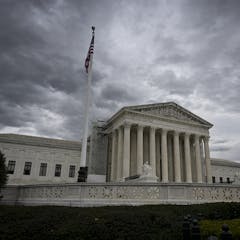
Articles on Brett Kavanaugh
Displaying 1 - 20 of 56 articles

Pundits decried the Supreme Court justices for not focusing on Donald Trump’s conduct when they heard oral arguments in Trump’s immunity case. But a legal scholar says they were just doing their job.

These cases have asked the justices to consider how to apply some of the most sweeping constitutional protections – those of free speech – to an extremely complex online communication environment.

Right from the very beginning of the nation, there have been rules that limit the ability of the people to choose their leaders.

A Supreme Court ruling has upheld the right of Congress to pass laws about Native American tribes’ rights to self-government.

Courts have no army or police force to enforce their decisions. Their power rests on their legitimacy in the public eye. How does scandal affect that?

Major Supreme Court decisions and reversals last term are leaving some people, including this scholar on constitutional politics, wondering – what’s going on with the court?

Unlike in most countries, US Supreme Court justices enjoy life tenure. Some legal scholars believe that centuries-old custom, meant to protect judicial independence, no longer serves the public.

The justices who decided to overturn the abortion rights precedent of Roe v. Wade explained their reasoning, and signaled other precedents could be reversed as well.

The gun rights decision from the conservative majority on the Supreme Court signals a fundamental change in how the court reads the Constitution.

If the Supreme Court overturns Roe v. Wade, will it be out of step with America?

The Supreme Court ruled in 2008 that you have a constitutional right to have a gun in your home. Now, the justices will consider how far outside of the home that right extends.

There is value in observing legal precedent, but sometimes circumstances, logic or judges’ views determine it’s time to overturn it.

Support for the Affordable Care Act is at an all-time high.

Conservative justices are redefining religious freedom to mean the protection of individuals or groups to practice their faith as they see fit, argues a constitutional law expert.

The US Supreme Court is often less insulated from partisan politics than many Americans assume.

The judicial theory has been a major talking point during the past three Supreme Court nominations. But what does it actually mean?

Many Supreme Court nomination battles depended on whether the president’s party also had control of the US Senate.

A 6-3 conservative court will hear a broader range of controversial cases, shift interpretations of individual rights and put more pressure on local democracy to make policy decisions.

With a new vacancy on the US Supreme Court, Donald Trump has the opportunity to alter the court’s direction for decades. He’s not the first.

Was a friend-of-the-court brief filed with the Supreme Court by five Democratic senators a legal argument – or a political threat?
